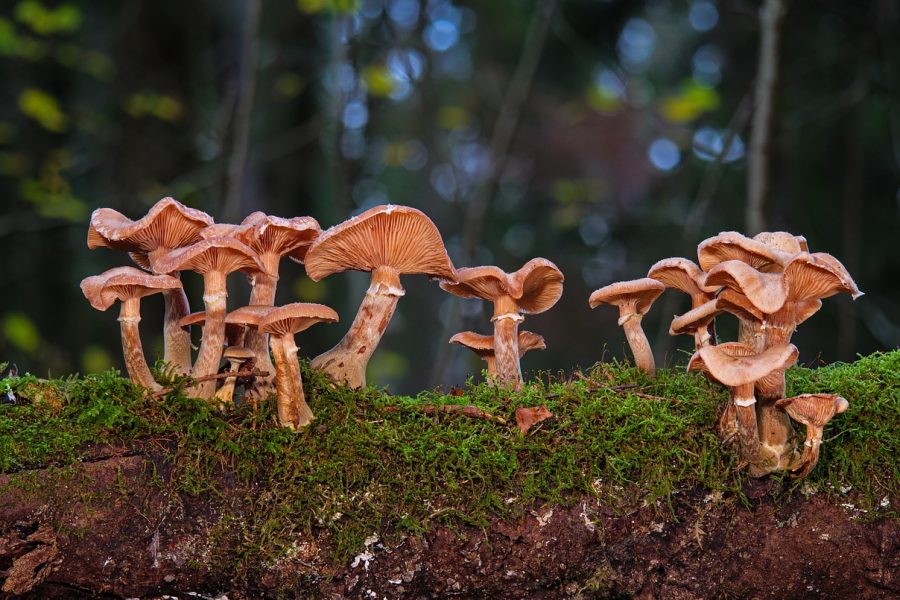
Bedtime story
28 July 2025
Communication is Key: An IPCC Education Report to Expand Outreach
28 July 2025By Julianna LEIBOLD
Fungi were some of the sole survivors of multiple mass-extinction events and can, hence, tell us a lot about the history of our earth. While only a small minority of fungi species are estimated to be discovered until today, known species already exhibit very impressive traits.
The mycelium of fungi connects to the roots of plants and forms the so called “wood wide web”, a system of communication and exchange of nutrients, which the fungus manages and which we still know very little about. By learning how to access the information gathered by fungi without damaging the large underground networks, we could gain important insights into specific ecosystems that would be great assets in biodiversity conservation. Studies have further shown that fungi play a crucial role in trees’ ability to adapt to climate change and the alarming perishing of trees is largely tied to disruptions in mycorrhizal relations.
Penicillin is won from the penicillium chrysogenum or the aspergillus nidulans fungus. As climate change proceeds, the risk for new diseases increases alongside antimicrobial resistance, driven, amongst other factors, by the excessive usage of antibiotics in the livestock sector. Here, the discovery of new species of fungi might also lead to the discovery of new antibiotics.
But fungi are also relevant for climate change mitigation. They constitute a valuable vegan source of protein and can be used as an alternative to conventional leather. This helps reduce methane emissions from the livestock sector. By using mycelium for bricks and insulation both waste and CO2 emissions can be reduced. The usage of cement does not only contribute to approximately 3% of global annual emissions, it also has severe consequences for coast lines due to sand exports, which create conflicts and increase vulnerability to floodings in affected areas.
Using fungi for packaging can help reduce waste and keep oceans microplastic-free. In addition, fungi can digest waste, speeding up recycling processes immensely. This is specifically interesting for waste that is usually hard to recycle due to toxins or because of its huge volume, such as cigarettes, agricultural waste, and diapers. The pleurotus and purpureocillium lilacinum mycelium have even been shown to split up the components of glyphosate into safe substances in isolated experiments. Education on farming and scavenging for mushrooms has been proven to improve food security of vulnerable populations. Reducing nitrogen and pesticide usage and favouring traditional regional varieties can improve mycorrhizal relations between crops and fungi, which in turn reduce the need for fertilisers. These relations are crucial for climate resilient agriculture.
The important role fungi play both in the climate and weather system could be explored more.
On a different note, a lack of interest from conventional sciences has given rise to the ‘Radical Mycology Movement’. This grassroot organisation of citizens seeks to form its own ‘mycelium of researchers’ in a time in which knowledge is increasingly becoming a commodity.
Mycology makes us rethink our hegemonic concepts of ‘science’ and strive to value indigenous perspectives and citizen science in research and in education, fungi can inspire system-thinking. Historians have further illustrated our impressive co-evolution with fungi, which places us right where we belong; inside the web of reciprocal relationships between organisms, which constitutes this earth.
References
Cement (no date) IEA. Available at: https://www.iea.org/energy-system/industry/cement. (Accessed: 08 April 2024).
McCoy, Peter (2016). Radical Mycology: A Treatise on Seeing & Working with Fungi. Chthaeus Press.
Mouterde, P. and Depardon, M. (2022). “India’s ‘sand mafias have power, money and weapons’” Le Monde.fr. Available at: https://www.lemonde.fr/en/environment/article/2022/09/12/in-india-sand-mafias-have-power-money-and-weapons_5996639_114.html. (Accessed: 08 April 2024).
Norris, Jessica H. (2016). “Non-Profit Spotlight: Radical Mycology.” Winter Solstice 2016: 14;4. Biohabitats. Available at: https://www.biohabitats.com/newsletter/fungi/non-profit-spotlight-radical-mycology/. (Accessed: 08 April 2024).
Sheldrake, Merlin. (2020). Entangled Life. Bodley Head.
Spinelli V, Ceci A, Dal Bosco C, Gentili A, Persiani AM. (2021). “Glyphosate-Eating Fungi: Study on Fungal Saprotrophic Strains’ Ability to Tolerate and Utilise Glyphosate as a Nutritional Source and on the Ability of Purpureocillium lilacinum to Degrade It.” Microorganisms. 20;9(11):2179. doi: 10.3390/microorganisms9112179.


